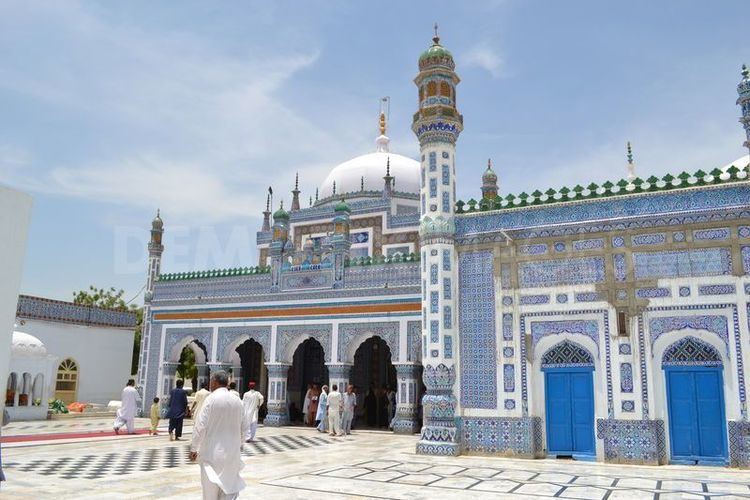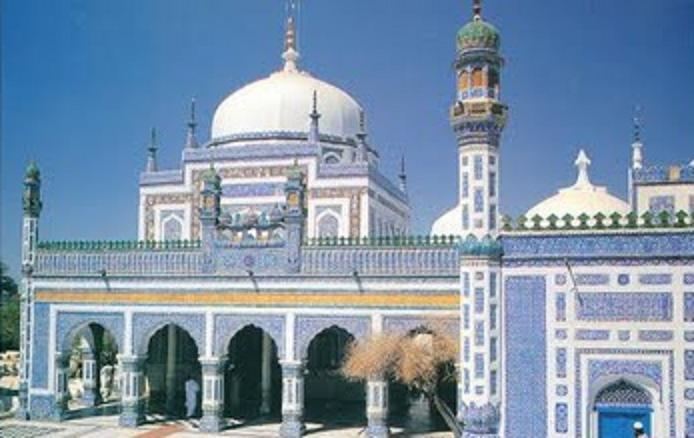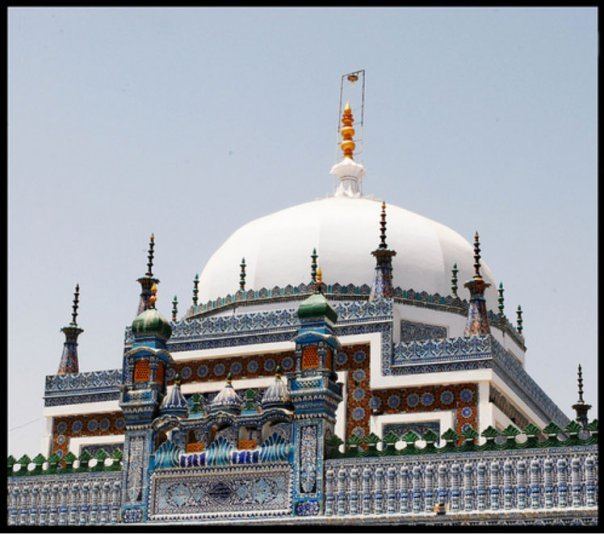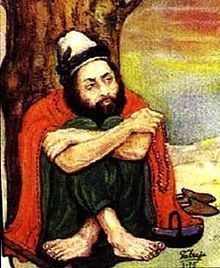Tradition or genre Poetry Role Poet | Name Shah Latif | |
 | ||
Died January 1, 1752, Bhit, Pakistan Books Shah Jo Risalo, Seeking the Beloved Similar People Sachal Sarmast, Shaikh Ayaz, Bulleh Shah, G M Syed, Lal Shahbaz Qalandar | ||
Shah Abdul Latif Bhittai Jo Risalo.flv
Shah Abdul Latif Bhittai (also referred to by the honorifics: Lakhino Latif, Latif Ghot, Bhittai, and Bhitt Jo Shah) (1689 – 1752) (Sindhi: شاه عبداللطيف ڀٽائي, Urdu: شاہ عبداللطیف بھٹائی) was a noted Sindhi Sufi scholar, mystic, saint, and poet, widely considered to be the greatest Muslim poet of the Sindhi language. His collected poems were assembled in the compilation Shah Jo Risalo, which exists in numerous versions and has been translated into English, Urdu, and other languages. His work has been compared frequently to that of the Persian poet Rumi. Seyyed Hossein Nasr, Professor of Islamic studies at George Washington University, described Shah Latif as a "direct emanation of Rumi's spirituality in South Asia."
Contents
- Shah Abdul Latif Bhittai Jo Risaloflv
- Shah Abdul Latif Bhittai Shah jo Risalo Sur Kalyan Dastan 1 By Sajid Chakrani And Marvi Ali
- Bhittais ancestry
- The early life
- Appearance and characteristics
- Shahs Journey of Sindh
- Piety and ascetism
- The final years
- The Urs
- In Popular culture
- References

Shah Abdul Latif Bhittai Shah jo Risalo Sur Kalyan Dastan 1 By Sajid Chakrani And Marvi Ali
Bhittai's ancestry

According to most scholars, Shah Abdul Latif Bhittai's lineage goes back to the Hirat. He however used the term "Shah" as a surname. His elders had migrated to Sindh during the era of Timur.

Shah Abdul Karim Bulri (1600s), whose mausoleum stands at Bulri, about 40 miles from Hyderabad, a mystic Sufi poet of considerable repute, was his great, great grandfather. His verses in Sindhi are existent and his anniversary is still held at Bulri, in the form of an Urs.

His father, Syed Habib Shah, lived in Hala Haveli, a small village, about forty miles from Matiari and not far from the village of Bhitshah. Later he left this place and moved to Kotri, where Shah Abdul Latif Bhittai spent some part of his adolescent life.
The early life

Shah Abdul Latif was born to Shah Habib in the village of Hala Haveli, a few miles to the east of the present town of Bhit Shah (named after him), on Safar 14, 1102 A.H. i.e. November 18, 1690 CE. Latif was raised during the golden age of Sindhi culture. His first teacher was Akhund Noor Muhammad Bhatti although he was largely self-educated. Although he received little formal education, the Risalo provides proof that he was well-versed in Arabic and Persian. The Qur'an, the Hadiths, the Masnawi of Maulana Jalaluddin Rumi, along with the collection of Shah Karim's poems, were his constant companions, copious references to which are made in the Shah Jo Risalo. He is also known for his calligraphy and hand writing skills. He made several copies of the Qur'an.
His correspondence in Persian with contemporary scholar Makhdoom Moinuddin Thattvi, as contained in the Risala-i-Owaisi, bears witness to his scholastic competence:
In his poems he writes about Sindh and its neighboring regions, he mentions distant cities such as Istanbul and Samarqand as well as Sindhi sailors (Samundi), their navigation techniques, voyages as far as the Malabar coast, Sri Lanka and the island of Java.
Most of the information on the life of Bhittai has been collected from oral traditions. A renowned Pakistani scholar, educationist, and a foremost writer of plays, dramas and stories, Mirza Kalich Beg has collected details about the early life of Shah Bhittai from the dialogues that he has constantly held with some of the old folks, still living at that time, who knew these facts from their fathers and grandfathers for they had seen Shah Latif in person and had even spoken to him.
Appearance and characteristics
In appearance, Bhittai was a handsome man, of average height. He was strongly built, had dark brown eyes, with a broad and high forehead. He grew a beard of the size of Muhammad's beard. He had a serious and thoughtful look about himself and spent much time in contemplation and meditation, since he was concerned about his moral and spiritual evolution with the sole purpose of seeking proximity of the Divine. He would often seek solitude and contemplate on the burning questions running through his mind concerning man's spiritual life:
Although he was born in favored conditions, being the son of a well-known and very much respected Sayed family, he never used his position in an unworthy manner, nor did he show any liking for the comforts of life. He was kind, compassionate, generous and gentle in his manner of speech and behaviour which won him the veneration of all those who came across him. He had great respect for woman, which, unfortunately, the present day Waderas do not have, and he exercised immense reserve in dealing with them, in an age when these qualities were rare. He hated cruelty and could never cause physical pain to any man or even to an animal. He lived a very simple life of self-restraint. His food intake was simple and frugal, so was his dressing which was often deep yellow, the colour of the dress of Sufis, jogis, and ascetics, stitched with black thread. To this day, his relics are preserved at Bhitsah (where his mausoleum stands), including a "T"-shaped walking stick, two bowls, one made of sandal-wood and another of transparent stone, which he used for eating and drinking. His long cap and his black turban are also preserved.
Shah's Journey of Sindh
In quest of religious truths, Shah Abdul Latif Bhittai traveled to many parts of Sindh and also went to the bordering lands as far as Multan, Lasbella, Jaisalmer and Bhuj. He became well known to the rulers at height of the power and rule of Kalhoras in Sindh. However he traveled unilaterally in the company of Jogis and Samis and some times alone visiting towns and cities, to understand the true message of Islam contained in nature. Throughout his travels he went to hills, valleys, riverbanks, fields and mountains where he met the ordinary simple people. He also traveled to the Ganjo Takkar( Barren Hills) in the south of Hyderabad, Sindh.
His poetry contains the adventures of Samundis (Sindhi Sailors) and their voyage to Lanka and Java, in Sur Surirag and Sur Samundi, which feature various accounts on cultural,social and economic outlook on people of Thatta and the port Debal in present day Karachi. For three years, he traveled with jogis and sanyasis, in search of the truth, peace, and harmony in the mountains of Lasbella. At several places in the Risalo, mention has been made of these jogis and of his visits to these wonderful, holy and peaceful places. He also travelled to such far away places in the Thar desert such as Junagadh, Jaisalmer.
Piety and ascetism
By the time he was a young man of twenty one years, he began to be known for his piety, his ascetic habits and his absorption in prayers. Observation and contemplation were chief traits of his character. A number of people flocked round him adding to the already large number of his disciples. This aroused jealousy of some powerful, ruthless, tyrannical persons - landlords, Pirs, Mirs, and Rulers - who became his enemies for some time. Later, seeing his personal worth, and the peaceful and ascetic nature of his fame, abandoned their rivalry. At this time he was living with his father at Kotri, five miles away from the present site of Bhitshah. It was here that his marriage was solemnised in 1713 CE with Bibi Sayedah Begum, daughter of Mirza Mughul Beg. She was a very virtuous and pious lady, who was a proper companion for him. The disciples had great respect for her. They had no children.
In the true ascetic spirit, Shah Latif was now in search of a place where in solitude, he could devote all his time in prayers and meditation. Such a place he found near Lake Karar, a mere sand hill, but an exotic place of scenic beauty, four miles away from New Hala. This place was covered by thorny bushes surrounded by many pools of water. It was simply and aptly called 'Bhit' (the Sand Hill). On the heaps of its sand stones he decide to settle down and build a village. As it was sandy, he along with his disciples dug out the hard earth from a distance and covered the sand with it to make the ground firm. After months of hard labour, carrying the earth on their heads and shoulders, the place was now fit enough for the construction of an underground room and two other rooms over it, along with a room for his old parents. A mosque was also built and the houses of his disciples properly marked out. In 1742, whilst he was still busy setting up a new village, Bhit, he got the sad news of the death of his dear father.. Soon after this Shah Latif shifted all his family members from Kotri to Bhitsah, as the village now began to be called. His father was buried there, in accordance to his will, where his mausoleum stands only eight paces away, from that of Shah Abdul Latif, towards its north.
The final years
For the last eight years of his remarkable life, Shah Latif lived at Bhitshah. A few days before his death, he retired to his cave-shaped room and spent all his time in prayers and fasting, eating very little.
After 21 days in there, he came out and after taking bath covered himself with a white sheet and asked his disciples to sing and start the mystic music. This went on for three days continuously, when the musicians, concerned about the motionless poet, found that he had died. The date was 14th Safar 1165 Hijra corresponding to 1752 CE. He was buried at the place where his mausoleum now stands, which was built by the ruler of Sindh, Ghulam Shah Kalhoro. The work of the construction of the mausoleum was entrusted to the well-known mason, Idan from Sukkur. The mausoleum, as well as the mosque adjoining it, were later repaired and renovated by another ruler of Sindh, Mir Nasir Khan Talpur. A pair of kettle drums, that are beaten every morning and evening even till today by the fakirs, jogis and sanyasis, who frequent the mausoleum, were presented by then Raja of Jaisalmer.
According to Sindhi scholars, young historian such as Abul Hassan Thattvi,author of the Muqadamah as-Salawat, sought advice from the elderly Shah Abdul Latif Bhittai during compilation of his celebrated work and frequently traveled to Bhit Shah.
It is reported that in his final years Latif visited Luari to meet Sultan-al-Aoliya Khawaja Muhammad Zaman. In this meeting Latif expressed desire to become his disciple. Muhammad Zaman put condition to withdraw from music as it is not allowed in Naqshbandi Sufi sect. Latif replied that "I have spent whole of my life playing these instruments and sufi music, in this last part of my life I cannot surrender it". After this meeting Latif is said to have repeatedly recited this verse in praise of Muhammad Zaman: '''' ''''سي مون ڏٺا ماء جنين ڏٺو پرين کي''''
''''تنين سندي ڪا ڪري ن سگھان ڳالھڙي''''''' ' "O mother! I have seen those who have seen the Beloved
I am speechless and of them nothing more can be told."
The Urs
The Urs is a grand festival in Sindh, where people from almost every village and town of Sindh and from different cities of other provinces of Pakistan - rich and poor, young and old, scholars and peasants - make a determined effort to attend.
The Urs commences every year from 14th Safar (2nd month of Hijra calendar) and lasts for three days . Along with other features, like food fairs, open-air markets selling Ajrak and Sindhi Caps among others, and entertaining and competitive sports, a literary gathering is also held where papers concerning the research work done on the life, poetry, and message of Bhittai, are read, by scholars and renowned literary figures. His disciples and ascetics, singers and artists, gather around and sing passages from his Risalo. Scholarly debates and exhibitions of his work and traditional Sindhi artifacts are also organised.
